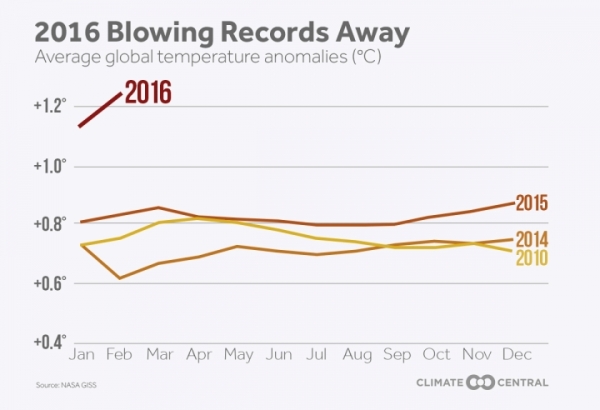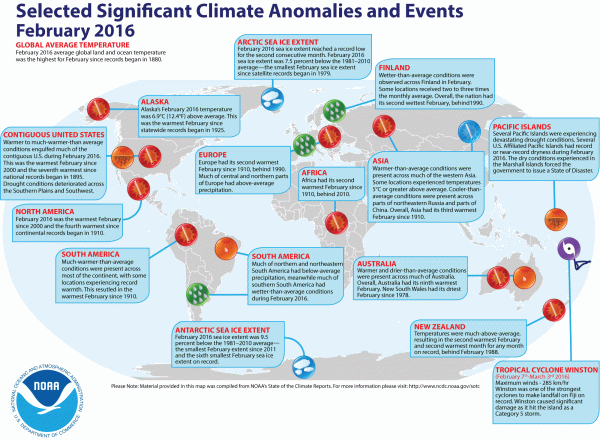World Meteorological Organization — Dangerous Climate Future Has Arrived
The
alarming rate of change we are now witnessing in our climate as a
result of greenhouse gas emissions is unprecedented in modern
records.
— Petteri
Taalas, Secretary General of the World Meteorological Organization
*****
21
March, 2016
It
would be a bit of an understatement to say that the global scientific
community is reeling. Sure, the various scientists and researchers
knew that a massive accumulation of greenhouse gasses in the Earth’s
atmosphere and oceans was beginning to take a serious toll. They knew
that ocean heat content in the top 2,000 meters of the world ocean
system (accounting
for 93 percent of Earth System warming)
was going through the roof. And they knew that this warmth was going
to bleed out in a seriously big and bad way as a
record El Nino swept through the global climate system during 2014,
2015 and 2016.
(Temperature
averages for 2016 are so far about 1.22 C above the 1951 to 1980
baseline or about 1.44 C above 1880s averages. Though temperatures
should fall somewhat as El Nino cools off in the Pacific, it’s
likely that 2016 comes in well hotter than the previous three record
warm years. Current guidance indicates a likely range of 1 to 1.13 C
above the 1950 to 1981 baseline or 1.22 to 1.35 C above 1880s
averages. This is uncomfortably close to 1.5 C warming levels the
Paris Climate Conference has stated a desire to avoid by the end of
this Century. Image source: Climate
Central.)
But
I’m pretty sure if you told these same scientists a year ago that
February of 2016 would see temperatures in the range of 1.43 to 1.57
degrees Celsius above averages seen during the 1880s, as we see now
in the three major global climate monitors (here, here and here),
they’d respond with not just a little incredulity.
“The
startlingly high temperatures so far in 2016 have sent shockwaves
around the climate science community,” said David Carlson,
Director of the World Climate Research Programme, in a
recent World Meteorological Organization press release.
Dr Michael Mann, a climate scientist at Penn State echoed
these sentiments —
“I think we all knew this would be a warm year due to the major El
Niño event. But I don’t think any of us expected such remarkable
and persistent record-breaking warmth.”
It’s
a new extreme record warmth that comes immediately following a major
global temperature ramp-up during 2015 — a period that the World
Meteorological Organization is calling alarming due
to an increasing number of severe climate impacts.
“Our planet is sending a powerful message to world leaders to sign
and implement the Paris Agreement on climate change and cut
greenhouse gases now before we pass the point of no return,” said
Mr Taalas, the WMO’s Secretary General in a press release
announcing its most recent State
of the Climate annual report.
World
Meteorological Organization — Dangerous Climate Change is Here
The
new report entitled — Hotter,
Drier, Wetter; Face the Future —
is scheduled to be released on March 23rd. It highlights a world
undergoing a fundamental and wrenching shift in its once-stable
climates. A shift that became all the more vivid during 2015 as the
pace of major climate change related events rapidly ramped up.
The
report highlights observations of record global surface temperatures,
record ocean temperatures within the top 2,000 meters of the worlds’
waters, and the highest sea levels ever recorded on a global
basis. The
report also noted that Winter Arctic sea ice during 2015 and 2016
were at the lowest extent levels ever observed in the satellite
record.
WMO also highlights major heat, wildfire and hydrological events
during 2015. Devastating heatwaves swept through India and Pakistan,
exceptional heatwaves scorched Western and Central Europe, and more
than 2 million hectares of Arctic forest burned in Alaska. WMO points
to a number of very extreme rainfall events around the globe
— particularly
highlighting a West African monsoon that in some places dumped 13
months worth of rainfall in just one hour.
Severe drought was also an issue for 2015 with Southern Africa
experiencing its worst drought since 1933 and Northern South America
and the Caribbean also seeing record dry conditions.
(The
WMO notes a number of extreme and significant climate change related
events in its most recent annual report. A series of events that,
according to monthly monitoring by NOAA, continued on into a record
hot February of 2016. Image source: NOAA.)
According
to WMO,
2015 also saw some of the most intense tropical cyclones ever
recorded with Pam, a category 5 storm, making landfall near Vanatu,
Mexico and Patricia reaching a peak intensity of 346 kilometers per
hour — the strongest storm ever to emerge in either the Eastern
Pacific or the Atlantic basin. A very rare hurricane Chapala also
churned ashore in Yemen. An event that was immediately followed by a
second similar cyclone — Megh.
Overall,
WMO notes that:
The year 2015 made history, with shattered temperature records, intense heatwaves, exceptional rainfall, devastating drought and unusual tropical cyclone activity… That record-breaking trend has continued in 2016. The theme Hotter, Drier, Wetter. Face the Future highlights the challenges of climate change and the path towards climate-resilient societies.
In
confronting that challenge, WMO calls for a redoubled effort to
rapidly reduce global greenhouse gas emissions to prevent runaway
global warming. However, WMO realistically notes that current
national pledges will likely result in about 3 C worth of warming
this Century unless even more aggressive action causes fossil fuel
based emissions to peak soon and swiftly decline.
WMO
recognizes that increasingly intense droughts, heatwaves and
wildfires will inevitably emerge due to the amount of warming that is
already locked in. WMO
recommends a set of climate resiliency enhancements to aid in climate
change related disaster response.
However, it is unclear if even the WMO realizes the level of threat
and difficult a rapidly warming world is now facing from an
increasingly dangerous and destabilized global climate system.
In
other words — that disorienting sensation scientists got from
looking at these terrifying temperature jumps during February is
about to become a lot more common for pretty much everyone. For from
the weather to the ice to the oceans to the very color of the sky —
things are about to get pretty darn weird.
Links:
(Note:
RS estimated temperature departures for 2016 have been revised upward
to 1.22 to 1.35 above 1880s averages [1 to 1.13 above the NASA 20th
Century baseline] in light of very high January, February and March
global temperature anomalies.)





No comments:
Post a Comment
Note: only a member of this blog may post a comment.